March 15, 2015 – Hard to believe it is already Day 5 and this morning the gang goes out to watch the whales. Yesterday on arrival the wind was blowing and it was hot, mid 30’s C (over 90 F). It never did get that cool overnight in Catavina, perhaps 20 C or 70 F. The drive was uneventful, a little windy at times but we took it easy, not a lot of regular Mexican traffic, we speculate the higher price of fuel is keeping many off the road. After arrival and set up in Guerrero Negro at Malarrimos we headed for Tony’s Tacos, we have been looking forward to them since we our last tour. Then off for a little shopping at the local Grocery store, a short tour of town, then back to the RV Park. I did find a shower that was working (the town was experiencing a power outage), and that felt great, even turned on only the cold to cool off. After a short siesta it was time for dinner, almost everyone joined us for dinner, we do like the Malarrimo Restauarant. Most had seafood which is always good, I had a filet mignon done to perfection, possibly one of the best I have ever had!


Only a couple of days ago we drove from Fidel’s on the beach inland and it was also warm there. The vistas on these drive are always so spectacular, even for me who has seen them so many times. We lots of company at Fidel’s most heading north, some south, all enjoying the beach and surf at the campground. Most of the gang put in some beach time, walking the endless surf, I had a wonderful hot shower. Fidel delivered a load of mesquite wood for our fire, which burns hot, little smoke and no sparks, perfect for hot dogs. Everyone had fun at the wiener roast, and folks brought other goodies, including marshmallows, flan, pineapple and lots of extra fixens. Everyone was looking forward to a fabulous sunset and perhaps even any opportunity to see the mystical green flash. However that was not to be as there was some cloud sitting just at the horizon, great sunset anyway.

After departing Fidel’s our journey to Catavina and the boulder Fields was wonderful, much less traffic and terrific vistas. Lisa & Luis will be very pleased with our stop at the Marmol Café as the group made many purchases. Lots of company at Santa Ines in Catavina, by the time night fell we had 24 RVs at the campground. When arrived we saw that Ralph’s 1950 Olds 88 Custom Camper was on a trailer. He had given to a young guy from Oregon who was taking it home to restore. It was hot for the Cave Painting tour but most made it, where I give my tutorial on early man in North America overlooking the arroyo we were joined by “Gus” the boulder gopher who never moved the whole time we were gathered around, only 6 feet away. Afterwards we went for dinner at Oscar & Matilda’s Motel Diner, food was perfect, you cannot get much more authentic than this. Later many sat watching the stars, always so clear at Catavina.


After the gang returns from Whale Watching we head off to San Ignacio and Rice & Beans where the majority of Baja Amigos state they have had the best Margaritas on Baja, we will see.
Did you know?
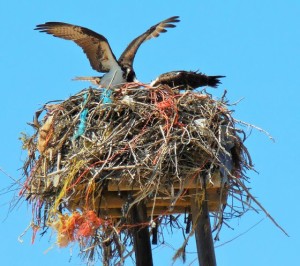
Cave Paintings of Baja California
On March and April 1962, archaeologist Clement Meighan accompanied an expedition, funded by mystery writer Erle Stanley Gardner, the creator of Perry Mason, to record “newly discovered” painted rock shelters in central Baja California. The group visited four rock-shelters on foot and photographed an additional five from a helicopter. Color photographs of the paintings appeared in an article by Gardner in Life and in his book, The Hidden Heart of Mexico, both of which were published that year. In 1966, Meighan published a scholarly account of the paintings and a small assemblage of artifacts collected at the sites in American Antiquity.
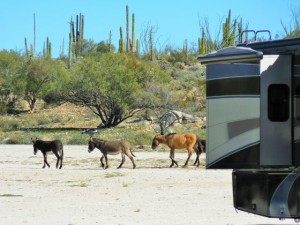
Today, more and more tourists are coming to Baja, many for whale watching or sea kayaking, but also to see the painted rock-shelters, which were added to UNESCO’s list of World Heritage Sites in 1993. When Meighan visited the region the sites were relatively unspoiled, “It is noteworthy that, with one exception (Palmarito), the sites visited showed no vandalism, pot hunting, or marking of the paintings with initials.” From 1994 to 1996, the Getty Conservation Institute and Mexico’s National Institute of Anthropology and History (INAH) studied one rock-shelter, El Raton, and installed signs and walkways at some of the others. Study of El Raton is being continued today by conservator Valerie Magar, of the Dirección de Restauración in Mexico City. INAH, meanwhile, has established regulations for visiting the sites.
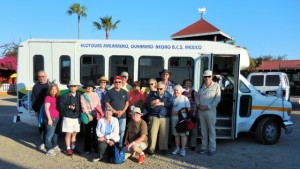
The painted rock-shelters were known to Spanish missionaries; those recorded by Meighan are between San Ignacio mission, founded in 1728, and Mission Santa Gertrudis, founded to north in 1751. Francisco Javier Clavigero, in his 1789 Historia de la Antigua o Baja California,was the first to describe the painted rock-shelters, noting pictures of men and women, and the different species of animals. These paintings, although crude, show the objects distinctly. The colors that served for them are clearly seen to have been made from the mineral earths which are found in the region of the volcano of Las Virgenes. The missionaries most admired the fact that those colors should have remained permanent in the stone through many centuries without being damaged by either air or water. Not feeling those pictures and dress to belong to the savage and brutalized nations which inhabited California when the Spanish arrived there, they doubtless belong to another ancient nation, although we cannot say which it was. The Californians unanimously affirm that it was a nation of giants who came from the north.
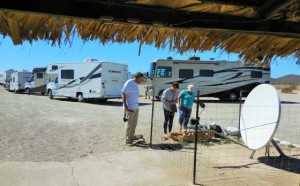
Although the California Indians have been asked the meanings of the paintings, rays, and characters they could not attain any satisfactory reason. The most that has been found out is that [the paintings] are of their ancestors and that those of today are completely ignorant of the meaning. (Translated. by C. Meighan in American Antiquity). As Meighan observed, the comments of the missionaries to which Clavigero refers must predate 1768, the year the Jesuits were expelled when Spanish lands were closed to the order.

French explorer Leon Diguet mentioned eight painted sites in his articles about Baja in L’Anthropologie (1895) and Nouvelles Archives des Missions Scientifiques (1899), but only one, San Borjita, whose 70 figures were described in the 1950s by Dahlgren and Romero and by Dahlgren de Jordan, had really been studied before Meighan’s report. The four rock-shelters seen by Meighan on foot are Flechas Cave (so-named by Meighan for a group of three human figures with arrows painted across their bodies), Palmarito (near the village of San Francisco), Pajaro Negro (named by Meighan for black paintings of birds, though its local name is Cueva de la Soledad), and Gardner (named after the expedition’s sponsor, but already known as Cueva Pintada). Of these, only Palmarito was also seen by Diguet.
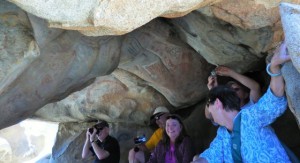
In these four rock-shelters Meighan recorded a total of 250 figures–humans, deer, mountain sheep, rabbits, birds, and fish–most life size or larger. The basic colors used included black (charcoal), white (a solidified volcanic ash), brick red (crushed lava), and orange red (ocher), with yellow (ocher?) considerably less frequent. Unlike the other colors, which required a binder, the white could be applied directly to the rock-shelter walls. The paintings were begun by outlining the figure, usually in white but sometimes in black, after which it was filled in with red, black, or both. Human figures could be split vertically, one side being painted red, the other black. Deer and mountain sheep could be divided horizontally into red and black halves.

Many of the animal figures had an arrow depicted either across them or stuck in them (generally in the back). The arrows were often done in white, at the same time the figure was outlined. Some 25% of the animals Meighan saw had such arrows. But the white color, applied directly to the stone, was susceptible to weathering and obliteration by overpainting so that in many cases such arrows have not survived. In fact, Meighan suggested, most originally had arrows. In the case of human figures with arrows, which are far fewer, there are as many as ten arrows on a single figure.

Animals were depicted life size or over, but human figures could be few inches to more than ten feet. The bodies of animals were shown in profile, with the heads in three-quarter or front view to accentuate horns of mountain sheep, antler of deer, and ears of rabbits. Humans are shown frontally, but lack facial features or distinguishing sexual characteristics. The style, Meighan concluded, was essentially static, with action implied but not indicated, e.g. arrows are shown stuck in animals but there is no depiction of a hunter shooting an arrow. Consistency of this style indicates that the paintings were executed over a relatively short period, which Meighan estimated to have been a few generations to at most two centuries. He did note some evidence of change in the paintings over this time. The few birds, depicted with outspread wings, seem to postdate most of the other paintings, and the smaller human figures also appear to be late, since they are seldom overpainted. This, Meighan suggested, may indicate some sort of “decline” or “cultural disruption.”
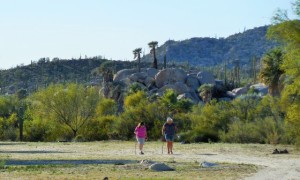
As with most rock art, the meaning of the Baja paintings remains obscure, though some of Meighan’s observations may be on the right track. The animals, for example, he said are not simply creatures depicted in nature but have been struck by a hunter’s arrow, and this implies a “cultural meaning associated with hunting magic.” Less clear is his preference for “witchcraft or black magic” rather than warfare as an explanation of the multiple arrows in human figures. Significantly, Meighan calculated that human figures are painted overtop animals at least three times more frequently than would be expected by chance. He interpreted this as an expression of human dominance. Placement of some of the paintings is curious. While most were on easily accessible walls and ceilings, some would have required a ladder or scaffolding, and others were executed in dangerous locations, e.g. on projecting roof over drop of several hundred feet. Such locations indicated to Meighan that the act of painting was more important than the painting itself.

Although none of the rock-shelters had deep deposits, Meighan collected a small assemblage (139 catalog entries, almost all from Cueva Pintada) from crevices where debris had accumulated, including flaked slate and basalt choppers and scrapers, obsidian projectile points, and sandstone manos and metates; bone awls and deer scapula “saws”; wood fire drill components, arrow foreshafts, pegs or stakes, a hook for harvesting cactus fruits, cut segments of cane and palm, and viznaga spines; basketry and net fragments, yucca fiber quids, cordage of yucca fiber, and a palm frond braid; marine shells and fragments; and an iron knife blade (a relic of a later visit to the site).
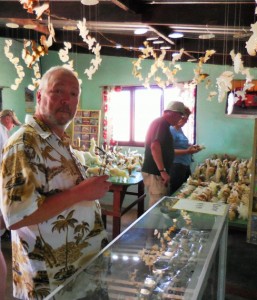
Bedrock mortars were ground into the rock-shelter floors, and there were abundant chipping debris and coarse stone tools on the slope at their mouths. No artifacts that would indicate how the paintings were made, such as brushes, were recovered. Meighan found that the artifacts from Cueva Pintada were similar to those from a rock-shelter at Bahia de Los Angeles, to the north, which belongs to the archaeological complex (a set of distinctive artifacts and other cultural features) known as Comondú. The Comondú painters were probably the ancestors of the historic Cochimí inhabitants of the area whose language is called Peninsular Yuman. A wooden peg from a crevice in Cueva Pintada yielded a date of 530 ± 80 years, or sometime between A.D. 1352 and 1512. This date, says Meighan, agrees both with Clavigero’s report of 1760s observation that Indians said the paintings were by an earlier people and with the late prehistoric and historic Comondú assemblage.
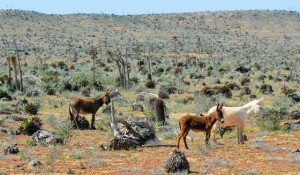
Stitching the slim evidence available to him into a narrative, Meighan devised the following tale: several hundred years ago, Peninsular Yumans in Baja were successful hunter-gatherers, subsisting on fish and shellfish, pitahaya cactus, rabbit, deer, and mountain sheep. As time passed, life became more difficult through the general desiccation of the Desert West, overhunting, or some other reason. Whatever prompted it, beginning perhaps 600 years ago, efforts to improve the supply of game supply were made through hunting magic involving the paintings. They failed, and the rock-shelters and painting were abandoned 200 years before the arrival of the Spanish. By time of the Jesuit missionaries, the population was probably smaller and the culture poorer than it had been for centuries. Meighan, offered an intriguing alternative cause for this decline–epidemic diseases–though he said it was “a wholly unprovable speculation.” The first Spanish in Baja were Ulloa in 1539, Cabrillo in 1542, and Vizcaino in 1602. Though the area was not missionized until 1700s, diseases may have outpaced the permanent Spanish settlement.
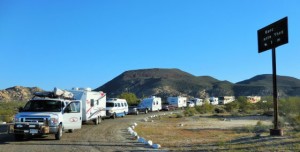
Recent chronometric dating of the paintings indicates they were created approximately 7000 years BP, before the present. [The whole question of archaeology has, at present, very few answers. Lucero Gutiérrez, INAH’s chief in the field, has said that there has been virtually no material uncovered in the vicinity of the painted places which can be reliably associated with the paintings or the painters. Rock shelters tend to attract tenants in all ages, for obvious reasons, but we need more evidence to equate any of their leavings with the art. The dating referred to above does not rule out the idea of some primordial “Comondú Culture”, but it does virtually eliminate any possibility of a connection with the three cultures found by the Spaniards.]

Next we have the fascinating journey of exploration, discovery and documentation of these Great Murals of Baja California by Harry W. Crosby in early 1970’s. The Great Murals of Baja California represent one of the corner-stones of the Bradshaw Foundation American Rock Art Archive. Firstly, the scale and execution of the Baja rock art paintings of animals and humans are unmatched in the New World. Secondly, these cave paintings, whose origins remain mysterious to this day, rank with those of Europe, Africa and Australia. The Cave Paintings of Baja California reveals Crosby’s adventures during a systematic search which required over nine months during a four year period. Guided by local ranchers, he traveled by mule and pack burros more than 1000 miles through the remote mountains of central Baja California. On this journey, the author visited over 200 previously undisclosed rock shelters painted in what he dubbed The Great Mural style. Crosby succeeds in presenting this veritable treasure trove with beautiful photography – cave paintings are notoriously difficult to photograph – and notably insightful observations and interpretations. Without question the Great Murals are highly significant, very sophisticated.
 Harry W. Crosby (born 1926 in Seattle, Washington) is an American historian and photographer. His parents moved to La Jolla in 1935. He graduated from La Jolla High School in 1944, and studied math and science at Occidental College in Los Angeles, completing a double major in pre-med and psychology. After twelve years as a teacher of secondary-level science, mostly chemistry, he took up photography, and in 1967, was hired as a photographer to illustrate the book The Call to California for the Commission of the Californias, commemorating California’s bicentennial. Following the route of the Portolá expedition of 1769 to make photos to illustrate a text derived from diaries of the trekkers, Crosby rode 600 miles on mule back on remote trails. Since then, he has continued to do primary research and to write extensively on the history and cave paintings of Baja California and the early history of Alta California.
Harry W. Crosby (born 1926 in Seattle, Washington) is an American historian and photographer. His parents moved to La Jolla in 1935. He graduated from La Jolla High School in 1944, and studied math and science at Occidental College in Los Angeles, completing a double major in pre-med and psychology. After twelve years as a teacher of secondary-level science, mostly chemistry, he took up photography, and in 1967, was hired as a photographer to illustrate the book The Call to California for the Commission of the Californias, commemorating California’s bicentennial. Following the route of the Portolá expedition of 1769 to make photos to illustrate a text derived from diaries of the trekkers, Crosby rode 600 miles on mule back on remote trails. Since then, he has continued to do primary research and to write extensively on the history and cave paintings of Baja California and the early history of Alta California.

His books include: The Cave Paintings of Baja California: Discovering the Great Murals of an Unknown People (Copley Books, 1975, reissued by Sunbelt Publications, San Diego, 1997); Gateway to Alta California: The Expedition to San Diego, 1769 (Sunbelt, 2004), which was a finalist for the 2003 Southern California Booksellers Association award; and Antigua California: Mission and Colony on the Peninsula Frontier, 1697-1768 (University of New Mexico Press, 1996), which won the 1995 Caroline Bancroft History Prize from the Denver Public Library. Some of Crosby’s early photography is collected in the book Tijuana 1964: A Photographic and Historic View (SDSU Press, 2000); and his only novel is Portrait of Paloma (Sunbelt, 2001).


For now, the origins, purpose, and demise of Baja’s magnificent paintings remain unknown and simply a mystery.

